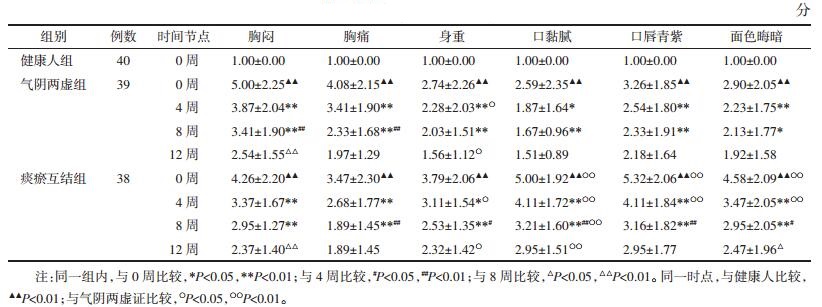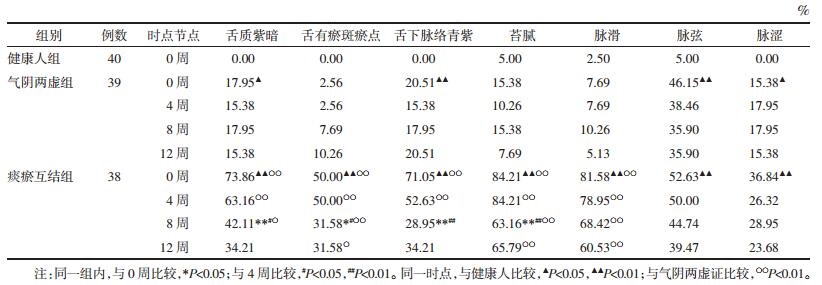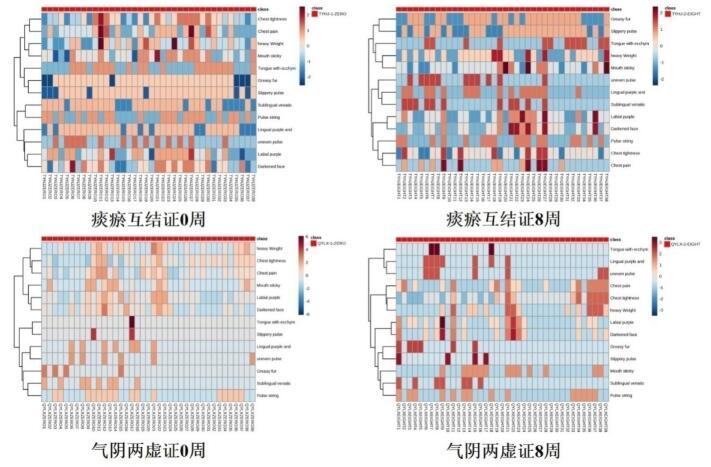文章信息
- 赵佳, 王旭, 高树明, 李琳, 高杉, 李春洁, 于春泉
- ZHAO Jia, WANG Xu, GAO Shuming, LI Lin, GAO Shan, LI Chunjie, YU Chunquan
- 冠心病稳定型心绞痛痰瘀互结证中医证候量表评价研究
- Comparative study on TCM syndrome evaluation scale of phlegm and blood stasis syndrome in coronary heart disease with stable angina pectoris
- 天津中医药, 2020, 37(6): 656-660
- Tianjin Journal of Traditional Chinese Medicine, 2020, 37(6): 656-660
- http://dx.doi.org/10.11656/j.issn.1672-1519.2020.06.14
-
文章历史
- 收稿日期: 2020-03-20
2. 天津中医药大学, 天津 301617
冠状动脉粥样硬化性心脏病(CAHD)系人体冠状动脉发生粥样硬化造成血管管腔狭窄、闭塞,进而出现心肌缺血缺氧甚至坏死的一类心脏疾病,简称冠心病(CHD)[1]。随着社会进步及人民生活水平的日益提高,CHD的发病率、病死率均呈现逐年增长态势,越来越多的研究表明,中医药在防治CHD及其并发症方面发挥了至关重要的作用[2]。通过对CHD的中医证候及复方临床观察研究,可进一步改善中医中药治疗CHD的临床疗效。从中医证候学角度分析CHD是多证素相关的疾病,但与痰浊、瘀血明确相关,临床痰瘀互结证较为常见[3]。
本研究采用课题组先期在继承CHD痰瘀互结证相关标准、研究论著、典型病例、专著文献研究的基础上,经过德尔菲法和层次分析专家咨询研制而成的《冠心病痰瘀互结证中医证候评价量表》,同时以健康人及与痰瘀互结证辨识度较高的气阴两虚证CHD患者作为对照,在全国7家临床研究中心开展“多中心、小样本、精细化”临床研究,以期更加准确地指导辨识冠心病痰瘀互结证,为临床提供参考依据。
1 资料与方法 1.1 一般资料124例受试者分别为2016年4月——2017年4月于上海中医药大学附属龙华医院、河南中医药大学第一附属医院、甘肃省中医院、天津市南开医院、天津中医药大学第一附属医院、天津中医药大学第二附属医院、天津市武清区中医医院就诊的患者或体检人群,因未完成访视脱失7例,最终纳入受试者117例,其中冠心病痰瘀互结证患者38例,男31例,女7例,平均年龄(57.53±5.38)岁,平均病程(48.08±42.47)月;冠心病气阴两虚证患者39例,其中男31例,女8例,平均年龄(55.80±6.93)岁,平均病程(52.78±53.67)月;健康人40例,男21例,女19例,平均年龄(43.97±8.17)岁。
1.2 诊断标准、纳入标准、排除标准、观察中止标准、治疗方法及合并用药规定本课题组根据美国心脏病学会和心脏协会(ACC/AHA)修订版制定的有关CHD心绞痛诊断指南,并参考“2007年中国慢性稳定性心绞痛诊断与治疗指南”[4],制定了CHD稳定性心绞痛患者西医诊断标准。CHD稳定性心绞痛患者诊断标准、纳入标准、排除标准、观察中止标准、治疗方法及合并用药规定等,详见本课题组既往研究[5]。
1.3 CHD稳定型心绞痛中医证候评价指标《冠心病痰瘀互结证中医证候评价量表》共分为胸闷、胸痛、身重、口黏腻、口唇青紫、面色晦暗、舌质紫暗、舌有瘀斑瘀点、舌下脉络青紫、苔腻、脉滑、脉弦、脉涩13个条目,根据症状的轻重程度将胸闷、胸痛、身重、口黏腻、口唇青紫、面色晦暗6个条目分为无、很轻、轻、中、重5个等级,其中无计1分、很轻计3分、轻计5分、中计7分、重计9分,舌质紫暗、舌有瘀斑瘀点、舌下脉络青紫、苔腻、脉滑、脉弦、脉涩7个条目分为有或无两种选项。
CHD患者评价时点为第0、4、8、12周,健康人为第0周。
1.4 伦理学审查本课题已通过天津中医药大学伦理委员会审查,伦理审查批件号为TJUTCM-EC20150001。
1.5 临床注册本课题分别在中国及美国临床试验注册中心完成注册,注册单位系天津中医药大学,国外注册号为NCT02526381,国内注册号为ChiCTR-OOC-15006765。
1.6 数据录入与统计分析使用EpiData 3.1数据库双人双录入数据,由培训合格的两名专业人员分别将数据录入计算机,采用Epidata3.1建立数据库,进行数据录入。将根据研究内容编写数据录入指南,并在数据录入前,对数据录入人员进行专门的录入培训。数据录入人员根据录入指南进行数据录入。
统计分析采用SPSS 24.0软件进行,计量资料以均数±标准差(
入组时,CHD痰瘀互结证与气阴两虚证患者与健康人比较,各项评分具有统计学差异(P<0.01),痰瘀互结证患者口黏腻、口唇青紫、面色晦暗评分及舌质紫暗、舌有瘀斑(瘀点)、舌下脉络青紫、苔腻、脉滑情况高于气阴两虚证患者(P<0.01)。
痰瘀互结证患者服用丹蒌片4周后,各症状评分及舌下脉络青紫情况较0周有所下降(P<0.05或P<0.01);治疗8周后,各症状评分及舌质紫暗、舌有瘀斑(瘀点)、舌下脉络青紫、苔腻情况较0、4周降低(P<0.05或P<0.01);第12周随访,胸闷、面色晦暗评分较8周有下降趋势(P<0.05或P<0.01)。
气阴两虚证患者各症状评分及舌质紫暗、舌下脉络青紫、脉弦、脉涩情况具有统计学差异(P0.05或P0.01)。服用通脉养心丸4周后,各症状评分较0周有所下降(P0.05或P0.01);治疗8周后,各症状评分及舌质紫暗、舌有瘀斑(瘀点)、舌下脉络青紫、苔腻情况较0周降低(P0.05或P0.01),其中胸闷、胸痛评分较4周呈下降趋势(P0.01);12周随访,胸闷评分与8周比较下降(P0.01)。结果见表 1、表 2。



|

|
CHD痰瘀互结证患者0周时,胸闷、胸痛、身重、口黏腻、舌有瘀斑瘀点、苔腻、脉滑可聚为一类,舌下脉络青紫、脉弦、舌质紫暗、脉涩、口唇青紫、面色晦暗聚为一类;8周时,苔腻、脉滑、舌有瘀斑瘀点、身重、口黏腻聚为一类,脉涩、舌质紫暗、舌下脉络青紫、口唇青紫、面色晦暗、脉弦、胸闷、胸痛聚为一类。而冠心病气阴两虚证患者0周时,身重、胸闷、胸痛、口黏腻、口唇青紫、面色晦暗聚为一类,舌有瘀斑瘀点、脉滑、舌质紫暗、脉涩、苔腻、舌下脉络青紫、脉弦聚为一类;8周时,舌有瘀斑瘀点、舌质紫暗、脉涩聚为一类,胸痛、胸闷、身重、口唇青紫、面色晦暗、苔腻、脉滑、口黏腻、舌下脉络青紫、脉弦聚为一类。
结果提示心绞痛症状如胸闷、胸痛可聚为一类,但与其余症状聚类结果较分散无明显规律,身重、口黏腻、苔腻、脉滑等痰证表现多聚为一类,口唇青紫、面色晦暗、舌质紫暗、舌有瘀斑瘀点、舌下脉络青紫等瘀证表现多聚为一类。见图 1。

|
| 图 1 冠心病痰瘀互结证中医证候评价量表聚类分析结果 Fig. 1 Cluster analysis results of traditional Chinese medicine syndrome evaluation scale of the phlegm and blood stasis syndrome |
近年间根据CHD的发病特点及治疗原则常将其分为两大类,即慢性冠脉病(CAD)和急性冠状动脉综合征(ACS)[6],其中稳定型心绞痛就是CAD最常见的类型之一[7]。稳定型心绞痛在中医理论指导下多归属于“胸痹”“心痛”范畴,研究表明痰浊与血瘀是胸痹发生发展过程中重要的病理因素及病理产物。近年来,随着人们饮食结构、生活方式的变化,如大量摄入高脂肪类食物,加之运动量降低,加剧了机体的脂质沉着、血脂升高及血细胞黏附,导致了痰浊与血瘀的发生发展,两者相互搏结,发为痰瘀互结证,而这一病理过程正与CHD的发生发展相吻合[8]。已有研究表明,血脂异常直接参与了CHD的发病[9-10],而痰瘀互结证亦是由高血脂症发生、发展而来[11],痰瘀互结可以对血管内皮细胞造成损害,致使血管产生增厚乃至硬化,导致了CHD的发生。
丹蒌片是痰瘀同治的代表方,化裁于《金匮要略》中的“瓜蒌薤白白酒汤”,方中瓜蒌皮、薤白为君药,丹参、川芎、赤芍、郁金为臣药,佐以骨碎补、泽泻、葛根,诸药合用治疗痰瘀互结所致胸痹心痛,具有益气通阳、化痰散结、活血化瘀的功效[12]。本研究冠心病痰瘀互结证患者服用丹蒌片后,量表学中各症状评分及部分舌脉状况较治疗前有所改善,在停药4周后随访疗效具有一定持续性,提示丹蒌片针对CHD患者痰浊及血瘀状态具有一定疗效。除此之外,0、8周的聚类结果提示本量表可初步区分患者的痰浊与血瘀状态。CHD气阴两虚证患者服用通脉养心丸4、8周后,各症状评分有所改善,随服药时间延长,部分舌脉情况也有一定程度减轻,停药4周后随访症状未见反复。另外,0、8周聚类结果显示部分症状呈现不典型聚类,提示可能与患者痰浊、血瘀状态不明显有关。同时,本课题研究结果表明,CHD患者与健康人3组在本量表各项指标不同时点存在一定程度差异,尤其在胸闷、胸痛等胸痹临床常见症差异较明显,以CHD痰瘀互结证更加突出。
综上,经对证用药治疗后,通过量表评价发现CHD稳定型心绞痛痰瘀互结证与气阴两虚证患者相关症状均有所改善,且不同证型的表现不同。《冠心病痰瘀互结证中医证候评价量表》可以为临床初步评判CHD稳定型心绞痛痰瘀互结证患者痰、瘀程度提供参考。
| [1] |
张守芳.参夏加桂合剂治疗冠心病稳定型心绞痛的临床疗效观察[D].济南: 山东中医药大学, 2016. ZHANG S F. The clinical study of Jiagui Shenxia Mixture on stable angina pectoris of coronary heart disease[D]. Jinan: Shandong University of Traditional Chinese Medicine, 2016. |
| [2] |
王朋.丹蒌片治疗老年慢性稳定型心绞痛(痰瘀互结型)的临床观察[D].沈阳: 辽宁中医药大学, 2016. WANG P. The clinical observation of Danlou Tabalet to treat elderly patients with chronic stable angina pectoris (phlegm and blood stasis type)[D]. Shenyang: Liaoning University of Traditional Chinese Medicine, 2016. |
| [3] |
牟宗毅, 张茂云, 陈颖. 冠心病心绞痛痰瘀伏邪证候要素研究[J]. 长春中医药大学学报, 2013, 2(2): 162-163. MOU Z Y, ZHANG M Y, CHEN Y. The research of TCM syndrome factors of phlegm and blood stasis fu evil in angina pectoris of coronary heart disease[J]. Journal of Changchun University of Chinese Medicine, 2013, 2(2): 162-163. |
| [4] |
中华医学会心血管病学分会, 中华心血管病杂志编辑委员会. 慢性稳定性心绞痛诊断与治疗指南[J]. 中华心血管病杂志, 2007, 35(3): 195-206. Chinese Medical Association Cardiovascular Branch, Editorial Committee of Chinese Journal of Cardiovascular Diseases. Guideline on the diagnosis and treatment of chronic stable type of angina[J]. Chinese Journal of Cardiology, 2007, 35(3): 195-206. |
| [5] |
徐一兰, 高杉, 许慧愚, 等. 冠心病稳定性心绞痛痰瘀互结证多中心、小样本、精细化临床研究方案[J]. 天津中医药, 2018, 35(2): 86-90. XU Y L, GAO S, XU H Y, et al. Study protocol for a multi-center, small sample, fineness trial of phlegm and blood stasis syndrome for coronary heart disease[J]. Tianjin Journal of Traditional Chinese Medicine, 2018, 35(2): 86-90. |
| [6] |
葛均波, 徐永健. 内科学[M]. 8版. 北京: 人民卫生出版社, 2013. GE J B, XU Y J. Internal Medicine[M]. 8th edition. Beijing: People's Medical Publishing House, 2013. |
| [7] |
董竞方.双参宁心颗粒对气虚血瘀型冠心病稳定型心绞痛患者治疗的临床观察[D].北京: 北京中医药大学, 2012. DONG J F. Shuangshen Ningxin Granules in treating stable angina pectoris of qi-deficiency blood stasis pattern[D]. Beijing: Beijing University of Chinese Medicine, 2012. |
| [8] |
李茂微.丹蒌片对大鼠冠心病痰瘀互结证的保护作用及其机制研究[D].长春: 吉林大学, 2015. LI M W. The protective effect and potential mechanisms of Danlou Pian on coronary heart disease with phlegm and blood stasis in rats[D]. Changchun: Jilin University, 2015. |
| [9] |
VARBO A, BENN M, TYBJA R A, et al. Remnant cholesterol as a causal risk factor for ischemic heart disease[J]. Journal of the American College of Cardiology, 2013, 61(4): 427-436. |
| [10] |
高杉, 张敏, 李琳, 等. 冠心病痰瘀互结证动物模型的建立及机制探讨[J]. 天津中医药, 2013, 30(12): 729-731. GAO S, ZHANG M, LI L, et al. The study on establishment and mechanism of animal model about coronary heart disease with phlegm and blood stasis syndrome[J]. Tianjin Journal of Traditional Chinese Medicine, 2013, 30(12): 729-731. |
| [11] |
闻莉, 刘松林, 梅国强. 高脂血症的中医临床证型分布及辨证规律研究[J]. 中国中医基础医学杂志, 2008, 14(3): 121-122. WEN L, LIU S L, MEI G Q. Study on the distribution and differentiation of traditional Chinese medicine syndrome types in hyperlipidemia[J]. Chinese Journal of Basic Medicine in Traditional Chinese Medicine, 2008, 14(3): 121-122. |
| [12] |
李琳, 王莹, 高杉, 等. 丹蒌片抗高脂血症的研究进展[J]. 天津中医药大学学报, 2014, 33(1): 61-64. LI L, WANG Y, GAO S, et al. Research progress on Doulou Tablets in Anti-hyperlipidemia[J]. Journal of Tianjin University of Traditional Chinese Medicine, 2014, 33(1): 61-64. |
2. Tianjin University of Traditional Chinese Medicine, Tianjin 301617, China
 2020, Vol. 37
2020, Vol. 37




